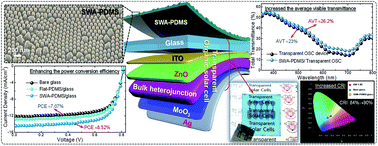Improved light harvesting efficiency of semitransparent organic solar cells enabled by broadband/omnidirectional subwavelength antireflective architectures†
Abstract
We report organic solar cells (OSCs) with subwavelength architectured polydimethylsiloxane (SWA-PDMS) as an antireflective (AR) layer on a glass substrate for not only enhancing the efficiency but also increasing the transparency of the devices. These subwavelength architectures (SWAs) on PDMS layers are fabricated using a soft imprint lithography technique via an anodic aluminum oxide mold. The effect of optical characteristics of SWA-PDMS with respect to the period and diameter of SWAs, along with the theoretical analysis using rigorous coupled-wave analysis simulation, is investigated. Consequently, the SWA-PDMS/glass with a period and diameter of 125 nm and 80 nm, respectively, is obtained as the optimal sample, exhibiting the highest average transmittance (Tavg) of ∼95.2%, which is much higher compared to that of bare glass (Tavg ∼92.08%). By employing the optimal SWA-PDMS on the glass surface of opaque and semitransparent OSCs as an AR layer, their power conversion efficiency is improved from 8.67 to 10.59% and 7.07 to 8.52%, respectively. Additionally, the average visible transmittance (AVT) of the semitransparent OSC is increased from 23.0 to 26.2% with significantly improved color coordinates as the AR layer is employed. Also, the OSCs with SWA-PDMS having a relatively high hydrophobic nature exhibit a stable performance in the ambient environment.



 Please wait while we load your content...
Please wait while we load your content...